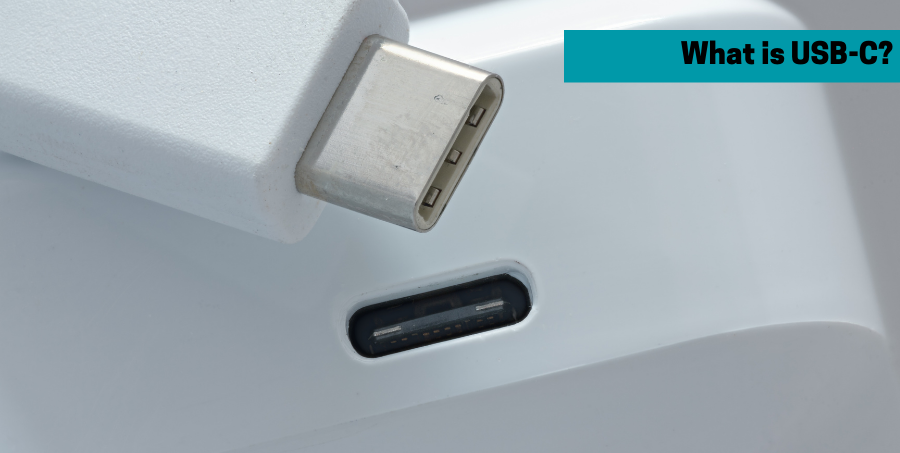USB-C: what is it?

Some of us are ancient enough to remember the Great Video Tech Battle between Betamax and VHS formats, and the resulting victory of VHS. Such is the nature of format innovations: new technologies are pitted against rivals until one emerges as market-leading champion. VHS enjoyed its dominant rule for some years, but was rudely deposed by a new contender for the tech throne, DVD, which in turn fell to Blu-ray, the slayer of the HD DVD competitor. Now, the empire of Blu-ray is itself waning, as online streaming services take centre stage.
USB-C, however, seems to be the exception to this tale of rise and fall. USB stands for ‘Universal Serial Bus’, and it’s looking increasingly like the ‘universal’ descriptor is an apt one. The latest USB Type C ports are starting to appear across the board, from the most basic external hard drives to top-drawer laptops and cutting-edge smartphones and tablets. Let’s dig beneath the surface and explore what this deceptively diminutive technology has to offer.
Just what is USB-C?
In a nutshell, it has fast become the dominant industry standard for charging the full gamut of computing devices and transferring data. The older USB standards – USB-A, 1, 2 and 3 – have now been superseded by the second-generation USB 3.1 data-transfer standard of most new USB-C ports.
In theory, the 3.1 standard can yield data transfer speeds of up to 10 Gbps – double the speed of the USB 3.0 standard. The specifications for the new standard were crafted in 2014, but only began appearing on devices and at the ends of cables in 2017. A few years later, they’re everywhere.
The first thing that the naked eye notices about the new standard is that the connector shape is much smaller than the clunky, jumbo-sized USB-A of yore (which is still in widespread use). Also, it’s not as frustratingly fiddly: you had to fumble for some time to make the connection ‘click’ with USB-A because it had to be inserted in exactly the right configuration. USB-C connectors superficially resemble their predecessor, the micro-USB – until you look a little closer. Unlike the latter, they’re wholly symmetrical in profile, so it doesn’t matter which way up (or down) they are when you push them into place.
Universal uptake?
The reason why it’s being adopted so ubiquitously is relatively easy to work out: it was developed by the USB Implementers Forum (USB-IF), a group consisting of no less than 700 big tech companies, including goliaths such as Apple, Microsoft, Dell, Intel, HP and Samsung.
It’s gaining in traction so rapidly that it’s fast becoming the go-to replacement standard for other powerful formats such as the uber-powerful Thunderbolt 3 and DisplayPort. There’s a strong probability that it will shortly also replace the standard 3.5mm audio jack (testing for this is underway at the time of writing).
Since they look so similar, are USB-Cs equivalent to Micro-USBs?
The short answer is no. They may bear a certain ‘family resemblance’, but this is superficial. Not only are their connectors mechanically ‘flippable’ when it comes to inserting them into place – the first time such a universal orientation has appeared in the last two decades – but also their data transfer rate is notably faster.
The versatility of USB-C
All devices are adopting this standard, so the day is approaching when you won’t need a tangle of differently formatted USB cables for various gadgets. This is already having an impact on the physical size of new devices: they’re slimmer and more compact, partly because they don’t need massive USB-A or HDMI ports if they’ve adopted the USB-C standard.
USB-C ports support a range of different protocols. All you need is a compact Multiport Adapter sitting neatly beside your laptop or smartphone on your desk, and a single USB-C port can be used for output to devices requiring HDMI, VGA, DisplayPort and USB-A connectors.
Backwards compatibility
Physically, you can tell at a glance that the USB-C connector with its small size and universal plug-in orientation isn’t compatible with older USB standards. However, it is compatible with the tech ‘inside’ them. Physical adapters are low-cost options that allow you to plug your device into all your existing peripherals.
What about USB 3.2?
USB-C actually refers to the shape of the port and connector. The numbers refer to the technology underneath. Most USB-C connectors today will support ‘USB 3.2 Gen 2x1’ technology, which is capable of the 10 Gbps data transfer speed mentioned earlier.
Earlier USB-C connectors support the older USB 3.0 technology with lower (5 Gbps) speeds, so it’s important to check when you’re purchasing one that it’s got a ‘10 Gbps’ or ‘USB 3.2 Gen 1x2’ designation on it.

